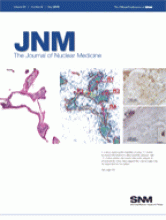REPLY: We greatly appreciate the interest of Dr. Nguyen and colleagues in our study (1), in which we concluded that ventilation–perfusion (V/Q) SPECT in combination with low-dose CT without contrast enhancement has an excellent diagnostic performance in patients suspected of having pulmonary embolism (PE).
Dr. Nguyen and colleagues raise an interesting point about the interpretation of perfusion SPECT alone, without low-dose or ventilation SPECT. However, as we concluded in our paper, a ventilation scan is mandatory because of the high number of false-positive test results and a specificity of only 51%. Perfusion can be used in combination with low-dose CT only if the scan results are negative (e.g., a high negative predictive value of 91%, as in our study) and, therefore, only as a rule-out test. From a subgroup analysis of our study, we concluded that planar V/Q lung scintigraphy had a specificity of 72%, which is still higher than the specificity of perfusion SPECT in combination with low-dose CT (2). Therefore, omitting the low-dose CT and using only perfusion SPECT would probably result in a low specificity and too many false-positive diagnoses.
In our study, we classified all scintigraphic mismatch defects as PE. Using PIOPED and PISAPED criteria is inappropriate because they were derived from single-view 133Xe ventilation and planar perfusion imaging, which is very different from V/Q SPECT (3). Reinartz et al. used a simplified reporting scheme that regarded all mismatch defects as PE, resulting in high sensitivity (97%) and specificity (91%) on V/Q SPECT (4). The best way to report V/Q SPECT has not been clarified. There seems to be a consensus about the need for a more simplified reporting scheme in V/Q SPECT reading, and therefore we chose to use Gestalt interpretation criteria (5).
We agree that V/Q SPECT is underutilized but could easily be applied as a routine method in most centers.
Footnotes
-
COPYRIGHT © 2010 by the Society of Nuclear Medicine, Inc.







